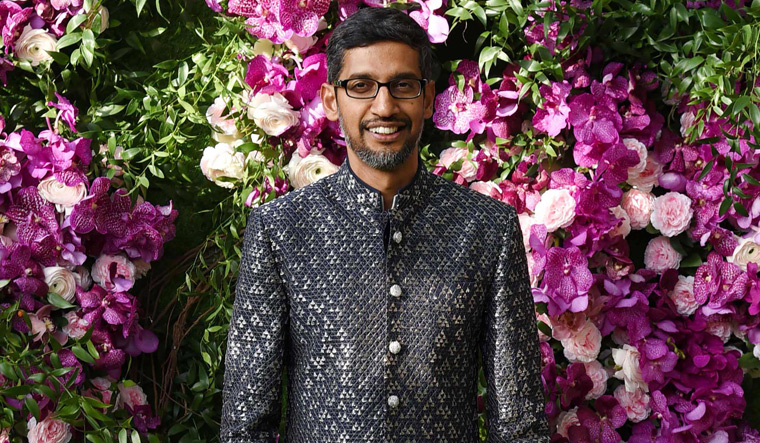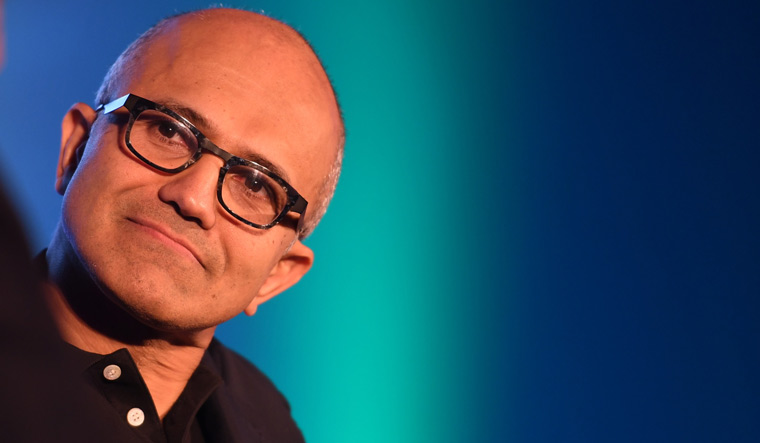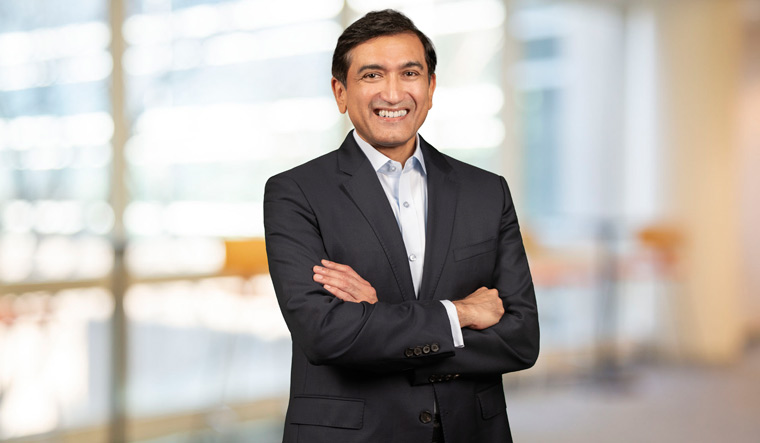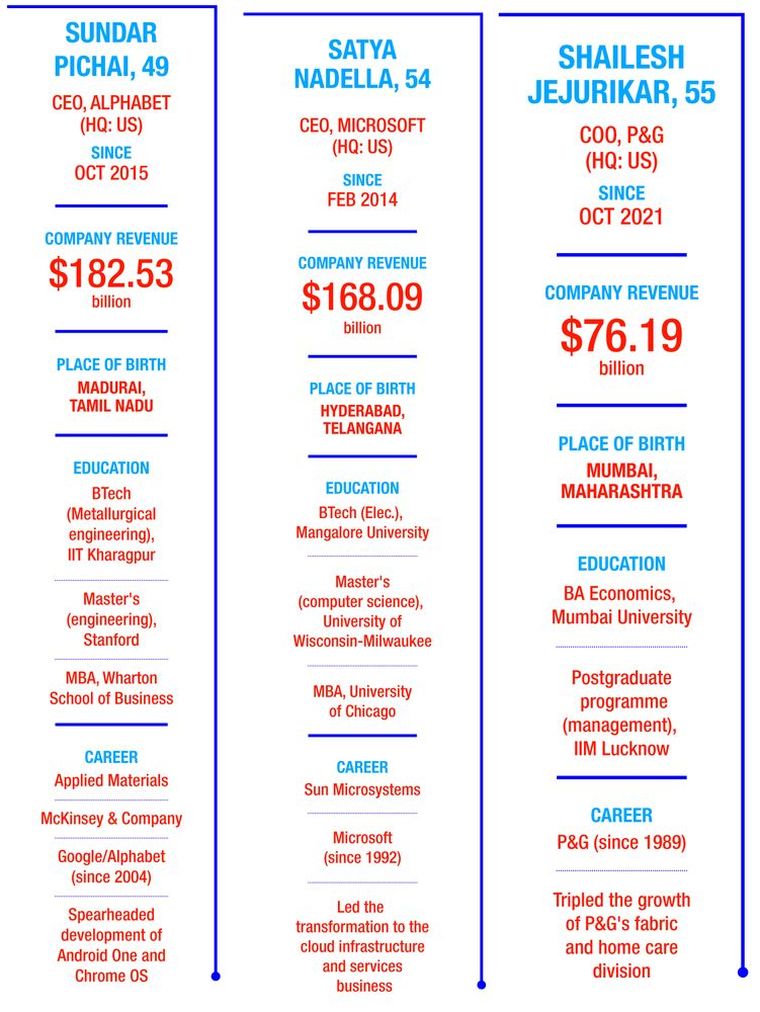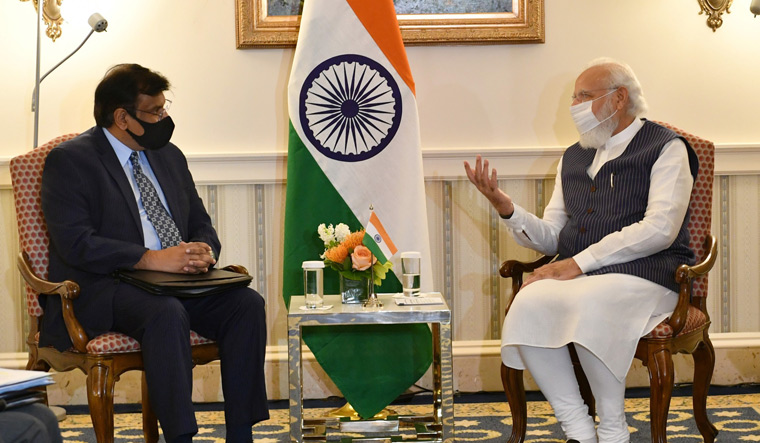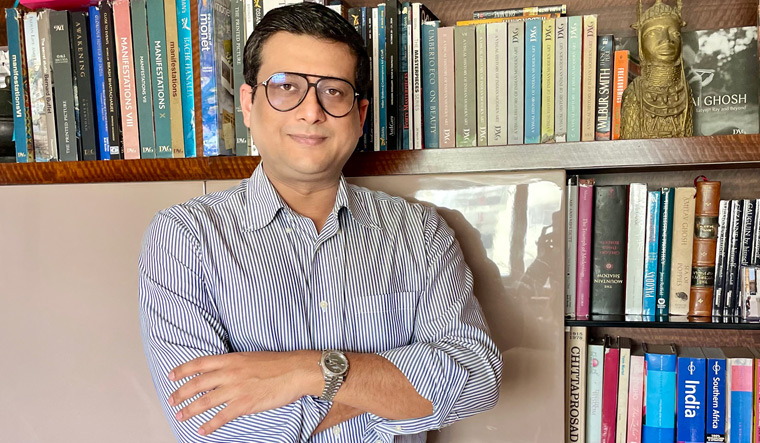I t is customary for visiting heads of governments to meet not just ministers and diplomats, but also captains of industry and leaders of society. It was during the visit of Indian prime minister Manmohan Singh to the US in 2009 that Pepsi chief executive officer Indra Nooyi, one of the earliest Indians to head a Fortune 500 company, found herself on such a list.
“When he got to me, prime minister Singh exclaimed, “Oh! But she is one of us!” Nooyi recounts in her autobiography, My Life in Full, released recently. President Barack Obama, with a big smile and without missing a beat, responded, “Ah, but she is one of us, too!”
A highlight of Prime Minister Narendra Modi’s official visit to the US in September was a meeting with the CEOs of five multinational companies. However, unlike a formal introduction before a state banquet or a tete-a-tete on the sidelines of a conference—where the personalities are selected keeping in mind the sensibilities of diversity and representation—the selection was purely based on business interests.
The five global CEOs who had an extended pow-wow with Modi were all heads of companies doing, or hoping to do, major business with India. There was an American solar company that is making a multi-billion dollar investment in India, a real estate firm and even a drone manufacturer with whom India was hoping to ink a substantial deal on AI-powered military drones.
Two of them were Indians—Shantanu Narayen of Adobe and Vivek Lall of General Atomics Global Corp. They made the cut not because they were of Indian origin, but because they led global corporations that were discussing business with one of their prominent markets. “As an Indian American, what could be more inspiring or a matter of pride than seeing what the prime minister is doing to really encourage startups and investments in India,” said Narayen after the meeting.
Equally inspiring has been the rise of Indian business leaders like Narayen himself, or Sunder Pichai of Google or Satya Nadella of Microsoft, on the global corporate stage. From the cliched generalisation of being a dork crunching code on his laptop in Silicon Valley, Indians have moved up the ranks, and in perception, to stake their claim on corner offices in some of the world’s biggest and most prestigious companies.
On October 1, Shailesh G. Jejurikar took over as chief operating officer of Procter & Gamble, one of the world’s biggest consumer goods companies. The Mumbai-born IIM Lucknow-alumnus was the CEO of the fabric and home care division of the company, its largest business segment, which makes brands like Tide and Ariel. Interestingly, Jejurikar’s replacement as CEO in the fabric and home care division was another Indian, Sundar Raman.
An estimate says about 30 per cent of Fortune 500 companies have Indians at their top echelons, a third of engineers in Silicon Valley are Indians and one in 10 of the world’s high-tech companies have Indian CEOs. As per a finding by Indiaspora, a non-profit organisation of Indians living abroad, 58 Indian-origin executives head various companies across 11 countries. Combined, these companies employ 36 lakh people and earn $1 trillion (about 074 lakh crore) in revenues. Their combined market capitalisation is around $4 trillion.
Though many of these CEOs are based in the US, the Indiaspora 58 come from places as far apart as Canada and Singapore, and include not just immigrants from India, but also those of Indian-origin from countries like Uganda, Ethiopia and the UK.
“I am amazed to see how far we have come in terms of representation of business,” said Raj Gupta, one of the first Indians to head a global company. He became CEO of Rohm and Haas, a multinational chemical manufacturer, in 1999. Gupta and Nooyi were pioneers of the Indian global CEO phenomenon.
Nooyi’s achievement, of course, was nothing short of trailblazing when she first became president of PepsiCo in 2001 and ascended to the CEO spot five years later. Not only was she a woman of colour, but she grew up in India and moved to the US only when she was 23. And Pepsi was not just a company that made fizzy drinks; it was one of the strongest symbols of American lifestyle and culture.
There was hardly any Indian presence in American corporate boardrooms those years to provide her with any template, let alone Indian women. “I was scared because I never wanted to let anybody down,” said Nooyi. “I was worried [about] how to make good on this role model designation I had, [and I] doubled down and worked hard to show that it can be done.”
That she did, by reconfiguring PepsiCo’s focus into healthier foods by adding Gatorade and Quaker Oats to the portfolio just at a time when the debate over junk food and eating clean were gaining traction. When she stepped down as CEO three years ago, after 12 long years at the helm, the company’s market capitalisation had risen by $57 billion.
Also read
- FedEx announces Indian-born Raj Subramaniam as new CEO
- We will see more Indians rising to high positions: Indra Nooyi
- This is just the beginning: Rajesh Subramaniam
- Immigrant values are changing the face of business: George Kurian
- India is a big area of investment for us: Shantanu Narayen
- Learning and unlearning
The spectacular achievements of some of the high-profile Indian corporate czars did help the global Indian CEO trend. How Pichai at Google and Nadella at Microsoft repositioned the behemoths to deal with change are classic cases in point.
“One of the major disadvantages of being so successful is that you tend to get stuck in your way of doing things—and this can be extremely dangerous in the tech industry where rules of the game change so fast,” pointed out George Paul, CEO of the tech industry body Manufacturers Association of Information Technology (MAIT). It was especially true for Microsoft and IBM, both giants firmly ensconced at the top of their segments at one point. IBM’s dominance in computer architecture and Microsoft’s stranglehold on operating systems meant that when the market diverged into the internet and mobiles, the companies suddenly found themselves out of step.
For Microsoft, rescue came in the form of Nadella, who refocused the company’s cloud-based services. “Nadella successfully transformed Microsoft into the new Microsoft we see today,” said Paul. “What he did was essentially understand the challenge and bring about a change in the organisation for today and a new tomorrow.”
At IBM, Arvind Krishna reinvented the legacy giant to make it nimbler. He spun off its infra services business and has made it clear that he aims to transform the company into a cloud management vendor.
The same has been the experience of Pichai, the tech honcho with a rock star halo. Google’s dominance in internet search and email services could well have blindsided it when Pichai joined the company in the mid-2000s, as the world suddenly swerved into mobile internet and cloud.
“Pichai recognised that this is how the internet is going to be accessed tomorrow. It was a dilemma Google faced,” pointed out Paul. Pichai’s rise to the top in 2015 followed years of excellence, as he rose through the ranks coming up with products that are household names today—Chrome, Google Maps and Android. “He brought clarity in the areas Google will focus on and the areas where Google will be in the background. This has helped Google move ahead,” said Paul.
Of course, it could have all gone wrong. One of the earliest Indians to head a global firm was Rajat Gupta when he became the managing director of the consultancy major McKinsey & Company in 1994. He was convicted for insider trading and sentenced to prison in 2012. He remained an aberration, as the trend over the past few years shows; the Indian ascendancy continues at a robust pace. But, what is it that makes Indian managers tick?
Business guru Gaurav Bhagat likens it to Sir Roger Bannister’s four-minute mile. The British athlete ran a 1,500 metres race in less than four minutes in 1964. “Until that day, everyone thought it couldn’t be done. However, once Bannister ran the mile in under four minutes, the impossible became possible. Amazingly, in a race a year later, there were three runners in the same race that achieved this feat,” he said.
Something similar, Bhagat said, was happening with Indians as global CEOs. “Once the first set of Indians started leading global companies and did exceptionally well in their roles, a lot of barriers came down and the floodgates opened,” he said.
The global business world first took note of India and its potential when the country opened up its economy in the 1990s. “A lot of global CEOs visiting India were also taking a lot of Indian managers back with them as senior managers,” said Bhagat.
The dot com boom in the late 1990s suddenly took many Indians to the west, and the contribution of Indian expertise to dealing with the Y2K crisis helped change the ‘land of snake charmers and yoga gurus’ image. “Once they started saying Indians were good engineers and software experts, the perception changed. And you could see more and more Indians going up the value chain in corporate America,” said Mukesh Aghi, president & CEO of the US-India Strategic Partnership Forum.
It is no coincidence that most of the better-known Indian CEOs in global corporations are not those born and brought up in the west, but are those who had humble beginnings back in India, who studied in Indian schools and colleges. Some, like Jejurikar, for instance, worked and proved their mettle in the Indian divisions of their companies before they were picked for international responsibilities.
This ‘Indianness’, in fact, often comes in handy. “Education is one thing and experience is another,” said brand consultant Harish Bijoor. “In the west, turmoil is an exception whereas, in India, it is the norm. And business equals turmoil. So, Indians do exceedingly well when it comes to turmoil management, disruption and creating new ways of doing things differently.”
English education and India’s multi-cultural background also help. “We have so many languages, so many cultures, so many religions. This helps because when you work in a multicultural environment, you learn to adjust, adapt and lead through consensus building,” said Aghi. Meeta Dasgupta, assistant professor at MDI Gurgaon, singled out their “humble beginnings” and “receptiveness to ideas.” “They are team players and good at building relationships,” she said.
Interestingly, this is one space where India seems to be beating the Chinese hands down. While China has its share of business giants on its home turf and Chinese make a decent showing at the startup front both at home and in the west, when it comes to heading global companies, Indians have stolen the thunder. A few years ago, Chinese telecom equipment major ZTE’s former India CEO Wang Tao sparked off a furore in China when he suggested that Indian corporate management would become “a secret weapon to overtake China”.
“Indians come from a democratic environment where you express opinions without hesitation, while Chinese come from a very different environment,” said Aghi. “Assimilating English early on also helps Indians communicate better. The third is the Indian value system, which is very similar to the Americans’—freedom, expressing opinions, diversity, openly challenging each other. These may not be similar to that of the Chinese.”
Detractors smirk at such observations, arguing that Indians CEOs are limited to tech companies, or at best financial companies. Though high-profile names like Nadella and Pichai reinforce this stereotype, it is far from the truth. “I am a living breathing example of exactly the opposite,” said Raj Subramaniam, the India-born president and chief operating officer of FedEx Corp.
Subramaniam is in august company. Vasant Narasimhan heads Novartis, the Swiss Pharma giant with 1.1 lakh employees around the world and $49.89 billion in annual revenues. Laxman Narasimhan is the CEO of Reckitt, the British multinational consumer goods company. Anshu Jain, earlier the global co-CEO and co-chairman of Deutsche Bank, Germany’s biggest financial institution, is currently president of the American financial services firm Cantor Fitzgerald.
Ivan Menezes from Pune heads Diageo, the world’s largest liquor company. His brother, Victor Menezes, was Citigroup’s chief financial officer and senior vice chairman. Reshma Kewalramani is MD & CEO of Boston-based Vertex Pharmaceuticals. Last year, Sandeep Kataria became the global CEO of the footwear giant Bata.
The saga is still unfolding. In the US alone, after many years of H1B visas and green cards, the Indian-origin population stands at 4.5 million. Multiply that manifold when you consider other global hubs of business. The recollection of Deb Mukherjee, founder & CEO of Ceres Foods, an Indian startup for packaged foods, from the time he worked as an R&D engineer in the UK more than a decade ago, encapsulates it. “In the entire facility of 1,500 people, I was the only non-European. I went back recently and the mix had changed completely, with a Pakistani heading the facility with loads of Indians and Europeans working for him. Is there a glass ceiling (for immigrants)? Rarely anymore for global companies.”
Everywhere all indications point to high-achieving Indians in middle and senior management, who are eager to move up the corporate ladder. “There used to be only a handful of us leading corporations,” said Raj Gupta. “Now that we are reaching prominence, I am eager to see how the next generation leaves its legacy.”



